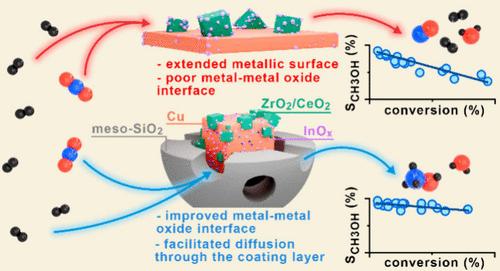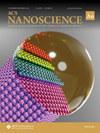在介孔二氧化硅包覆铜基催化剂上将二氧化碳加氢转化为甲醇
IF 4.8
Q2 NANOSCIENCE & NANOTECHNOLOGY
引用次数: 0
摘要
尽管化学促进作用对用于二氧化碳加氢制甲醇的铜基催化剂进行了重大改进,但超越结构限制(如反应条件下的活性相聚集)仍是一项挑战。在本报告中,我们通过在纳米颗粒上包覆介孔二氧化硅外壳,改善了 Cu/In2O3/CeO2 和 Cu/In2O3/ZrO2 催化剂的质构特性。这种策略将颗粒尺寸限制在 3.5 nm 以下,增加了金属的分散性,扩大了金属-金属氧化物界面区域。化学计量分析表明,这些结构可在多种反应条件下保持高活性和选择性,甲醇时空产率比未涂层催化剂高出 4 倍。本文章由计算机程序翻译,如有差异,请以英文原文为准。

CO2 Hydrogenation to Methanol over Mesoporous SiO2-Coated Cu-Based Catalysts
Although chemical promotion led to essential improvements in Cu-based catalysts for CO2 hydrogenation to methanol, surpassing structural limitations such as active phase aggregation under reaction conditions remains challenging. In this report, we improved the textural properties of Cu/In2O3/CeO2 and Cu/In2O3/ZrO2 catalysts by coating the nanoparticles with a mesoporous SiO2 shell. This strategy limited particle size up to 3.5 nm, increasing metal dispersion and widening the metal–metal oxide interface region. Chemometric analysis revealed that these structures could maintain high activity and selectivity in a wide range of reaction conditions, with methanol space-time yields up to 4 times higher than those of the uncoated catalysts.
求助全文
通过发布文献求助,成功后即可免费获取论文全文。
去求助
来源期刊

ACS Nanoscience Au
材料科学、纳米科学-
CiteScore
4.20
自引率
0.00%
发文量
0
期刊介绍:
ACS Nanoscience Au is an open access journal that publishes original fundamental and applied research on nanoscience and nanotechnology research at the interfaces of chemistry biology medicine materials science physics and engineering.The journal publishes short letters comprehensive articles reviews and perspectives on all aspects of nanoscience and nanotechnology:synthesis assembly characterization theory modeling and simulation of nanostructures nanomaterials and nanoscale devicesdesign fabrication and applications of organic inorganic polymer hybrid and biological nanostructuresexperimental and theoretical studies of nanoscale chemical physical and biological phenomenamethods and tools for nanoscience and nanotechnologyself- and directed-assemblyzero- one- and two-dimensional materialsnanostructures and nano-engineered devices with advanced performancenanobiotechnologynanomedicine and nanotoxicologyACS Nanoscience Au also publishes original experimental and theoretical research of an applied nature that integrates knowledge in the areas of materials engineering physics bioscience and chemistry into important applications of nanomaterials.
 求助内容:
求助内容: 应助结果提醒方式:
应助结果提醒方式:


